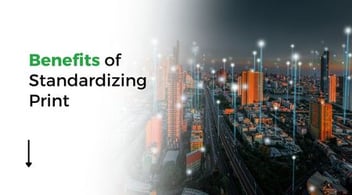How Has the COVID-19 Pandemic Impacted Managed Print Services?

In the early months of 2020, the COVID-19 Pandemic swept the world. Offices around the globe shut down to slow the spread of this new, unknown virus.
The forced exodus from traditional offices radically shifted the American workplace. And years after the initial outbreak, we can see lasting effects on how we live and work.
It should not be surprising to anyone that the pandemic had significant lasting impacts on managed print services (MPS) - an industry built on servicing large, paper-reliant office spaces.
Print Partner works with hundreds of managed service providers (MSPs) across the country and is no stranger to the many challenges the pandemic has presented over the past few years. Our parent company, Green Office Partner, is a national provider of MPS for clients around the US, and we’ve seen the shifts and adaptations in the printing industry first-hand.
In this article, we’ll review the lasting impacts of the pandemic on the managed print services industry.
The Shift to Remote Work
In the “before times,” most office workers would drive to work, clock in at 9 AM, sit at their desktop computer all day, and share a communal copier with the rest of the office.
It was a simpler time.
But then, everything changed when the pandemic swept through the world, forcing everyone to grab their lunches from the fridge, pack up their desks and work from home on laptops.
“Before the pandemic, three-quarters of working Americans did not work remotely at all, and only 6% primarily did remote work,” writes Patrick Coate of NCCI. “In 2020, COVID-19 forced almost over one-third of all workers to shift to work at home when they would not have done so otherwise.”
Three years after the initial outbreak, it’s clear that we’re not going to be reaching pre-pandemic levels of office populations anytime soon.
Jack Flynn from Zippia reports some very telling statistics about the shift to remote work:
- 26% of U.S. employees work entirely remotely as of 2022
- 66% of U.S. employees work remotely, at least part-time
- 16% of U.S. companies are fully remote
- 15% of work opportunities in the US are remote
In response to this massive shift, managed print providers have been forced to adapt to an environment that looked very different from pre-COVID conditions.
We’ll review some of the biggest challenges MPS has undergone to accommodate this shift to a remote working environment.
1. Decrease in Revenue
The shift away from physical offices has forced businesses to rely more on web-based information and less on paper-based printing.
It’s hard to pass hard copies of documents to coworkers working from their homes across town.
Have you seen the price of stamps these days? Yeesh.
Since most MPS vendors charge clients based on the number of clicks (pages printed), it's
not hard to imagine why MPS revenue would decrease.
Many MPS clients were far below their expected (contracted) print volumes. And those that were locked into contracts at the time often tried to renegotiate for new, less-expensive contracts that would better fit their now lower volume.
To learn more about print contracts, read: MSPs: How Your Clients Can Renegotiate MPS Contracts
2. Supply Chain Issues
With many businesses shifting around their resources, the pandemic disrupted supply chains across many industries.
“The pandemic continues to offer significant challenges for supply chains globally,” writes Sean Harapko of EY. “Even in 2022, national lockdowns slow or even temporarily stop the flow of raw materials and finished goods, disrupting manufacturing as a result.”
Print vendors were no exception to industries hindered by these supply delays.
The restrictions on movement and shipping and the closure of many businesses and manufacturing plants led to shortages of some printing supplies and equipment.
Many print vendors had to find alternative suppliers or adjust their supply chains to deal with the disruptions caused by the pandemic.
During the height of the pandemic, deliveries for copiers and printers were often delayed, leading to frustration on both the client side and the vendor’s side.
How have MPS Providers Adapted to Post-Pandemic Conditions?
In the face of financial and logistical challenges, print vendors have been forced to adapt to the post-pandemic world. Here are some of the main changes we’ve seen in our printing space.
1. MPS and Cloud-Based Managed Print Services
Because so many employees work from home, at least part of the time, many businesses shifted to cloud-based managed print services.
Cloud-based MPS means its users can securely print from their own devices at home and onsite without hassle.
Users can also print between locations: They can print on office copiers from home and print on home devices from the office.
Gabriela Garner of Kofax writes, “In-office printer management is centralized and easy to manage, even with a highly diverse MFD fleet.”
Here are some of the primary benefits of cloud-based MPS she lists:
- Automatic software and driver updates. Let the cloud handle this task, not IT—and spend far less time worrying about mismatched drivers, rollbacks, and troubleshooting.
- Enhanced connections to colleagues working from home. Ensure that employees remain connected to the company's print infrastructure, no matter where they are.
- Easier printing from users’ mobile devices, even away from the office.
2. Enhanced Security
Cloud-based and flexible printing is an excellent option for the many businesses that now facilitate a hybrid work environment.
However, an increase in ways to print brings vulnerability to data breaches and hacking.
If clients aren’t careful, they could easily send a print job for a highly-sensitive company document to their printer at home, where a random relative or friend could accidentally glance at it.
I don’t know whose family is snooping on their work-related print jobs… but you never know!
Slip-ups may seem unlikely, but sharing private information about the client company can result in loss of data, trust, and revenue. It can even lead to lawsuits - security is no joke!
To combat these vulnerabilities, MPS vendors have implemented more security measures, such as:
- Secure printing: users must verify personal data at the site of the device for the print job to resolve. This prevents strangers from picking up documents they shouldn’t.
- Data Encryption: When print jobs are sent to devices via the Internet, information is encrypted to prevent the interception of private data.
- Multi-Factor Authentication: Users must click a button on their cell phone or scan their fingerprints to use printing devices.
- Regular Security Audits: Print vendors review possible vulnerabilities in their security during quarterly business reviews or other regular meetings throughout the year.
While many of these techniques have been in place since before the pandemic, the frequency and complexity of these measures have all been enhanced to keep up with the many uncertainties of modern technology.
To learn more about how to keep print devices secure, read: Top 10 Tips for Printer Security
Print Partner and the Evolution of Print
Despite the many challenges to managed print over the last few years, Print Partner and our parent company, Green Office Partner, have continued to grow our business and stay ahead of the curve.
Our team is committed to collaborating with your MSP with the most up-to-date MPS technology available.
Whether your client business work from the office or home, we have solutions that can satisfy their needs.
Plus, we’ll pay you! For each deal we close, we’ll pay the person who registers the opportunity at least $500 for the introduction and an additional $250 per $25K in revenue the deal brings us. For the MSP, we’ll pay $1,000 per 11x17 MFP sold, $100 per printer sold, and 5% recurring revenue on the client’s print allotment. And we’ll provide exceptional client service while we’re at it.
So if you want to help your clients while creating a new revenue stream for your business, then partner with us, a Print Partner you can trust.



